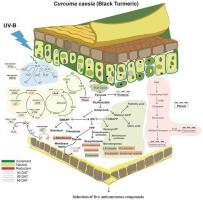当前位置:
X-MOL 学术
›
Environ. Exp. Bot.
›
论文详情
Our official English website, www.x-mol.net, welcomes your
feedback! (Note: you will need to create a separate account there.)
Alterations in growth, antioxidative defense and medicinally important compounds of Curcuma caesia Roxb. under elevated ultraviolet-B radiation
Environmental and Experimental Botany ( IF 4.5 ) Pub Date : 2020-09-01 , DOI: 10.1016/j.envexpbot.2020.104152 Deepanshi Jaiswal , Avantika Pandey , Arideep Mukherjee , Madhoolika Agrawal , Shashi Bhushan Agrawal
Environmental and Experimental Botany ( IF 4.5 ) Pub Date : 2020-09-01 , DOI: 10.1016/j.envexpbot.2020.104152 Deepanshi Jaiswal , Avantika Pandey , Arideep Mukherjee , Madhoolika Agrawal , Shashi Bhushan Agrawal

|
Abstract Ultraviolet-B (UV-B) radiation is a well-known stress factor, as involved in the generation of free radicals, and induction factor which permutates growth, metabolic processes, and secondary metabolites synthesis of plants. However, its impact on medicinal plants is less explored particularly in relation to secondary metabolites associated with the medicinally important rhizomes. An endangered medicinal plant (Curcuma caesia Roxb.) grown under natural field conditions was exposed to elevated UV-B (ambient ± 9.6 kJ m−2 d-1) to assess changes in growth, antioxidant profile, defense strategy and the secondary metabolites of the rhizome. Results showed that eUV-B induced the generation of different reactive oxygen species (·O2- radical and H2O2) which were counteracted by induction of UV absorbing pigments (flavonoids and anthocyanin), non-enzymatic (ascorbic acid) and enzymatic antioxidants (peroxidase, ascorbate peroxidase and catalase) at different growth stages. However, phenol, thiol and superoxide dismutase activity showed reduction at all the growth stages. Protection from UV-B was also manifested by an increase in total free radical scavenging activity, metal chelation and reducing activity. Alterations in biomass allocation might be a possible mechanism of defense which persuaded to higher increment in above ground biomass and tuber biomass with 47 % diminution of rhizome biomass. Among the four classes of compounds identified, sterols were increased whereas reductions were more prominent in fatty acids followed by monoterpenes and sesquiterpenes. Increased production of epicurzereonone, elemene, pinandiol, and 1,8-cineole whereas curcumenol, D-camphor, eucalyptol, curcumenone, isocurcumenol, and zederone were reduced. Elevated UV-B also induced the production of some anti-cancerous compounds such as furanodiene and caryophyllene.
中文翻译:

Curcuma caesia Roxb 的生长、抗氧化防御和药用重要化合物的改变。在升高的紫外线 B 辐射下
摘要 紫外线-B (UV-B) 辐射是众所周知的胁迫因子,参与自由基的产生,是改变植物生长、代谢过程和次生代谢产物合成的诱导因子。然而,它对药用植物的影响很少被探索,特别是在与药用重要根茎相关的次生代谢产物方面。一种在自然田间条件下生长的濒危药用植物(Curcuma caesia Roxb.)暴露于升高的 UV-B(环境 ± 9.6 kJ m-2 d-1)以评估生长、抗氧化特性、防御策略和次生代谢物的变化根茎。结果表明,eUV-B诱导了不同活性氧(·O2-自由基和H2O2)的产生,而这些活性氧被紫外线吸收色素(类黄酮和花青素)的诱导所抵消,不同生长阶段的非酶(抗坏血酸)和酶抗氧化剂(过氧化物酶、抗坏血酸过氧化物酶和过氧化氢酶)。然而,苯酚、硫醇和超氧化物歧化酶活性在所有生长阶段都显示出降低。总自由基清除活性、金属螯合和还原活性的增加也表明了对 UV-B 的保护。生物量分配的改变可能是一种可能的防御机制,它促使地上生物量和块茎生物量增加,根茎生物量减少 47%。在鉴定的四类化合物中,甾醇增加,而脂肪酸的减少更为突出,其次是单萜和倍半萜。增加表皮脲酮、榄香烯、蒎二醇和 1,8-桉树脑的产量,而姜黄素、D-樟脑、桉油精、姜黄酮、异姜黄醇和泽德酮减少。升高的 UV-B 还诱导产生一些抗癌化合物,如呋喃二烯和石竹烯。
更新日期:2020-09-01
中文翻译:

Curcuma caesia Roxb 的生长、抗氧化防御和药用重要化合物的改变。在升高的紫外线 B 辐射下
摘要 紫外线-B (UV-B) 辐射是众所周知的胁迫因子,参与自由基的产生,是改变植物生长、代谢过程和次生代谢产物合成的诱导因子。然而,它对药用植物的影响很少被探索,特别是在与药用重要根茎相关的次生代谢产物方面。一种在自然田间条件下生长的濒危药用植物(Curcuma caesia Roxb.)暴露于升高的 UV-B(环境 ± 9.6 kJ m-2 d-1)以评估生长、抗氧化特性、防御策略和次生代谢物的变化根茎。结果表明,eUV-B诱导了不同活性氧(·O2-自由基和H2O2)的产生,而这些活性氧被紫外线吸收色素(类黄酮和花青素)的诱导所抵消,不同生长阶段的非酶(抗坏血酸)和酶抗氧化剂(过氧化物酶、抗坏血酸过氧化物酶和过氧化氢酶)。然而,苯酚、硫醇和超氧化物歧化酶活性在所有生长阶段都显示出降低。总自由基清除活性、金属螯合和还原活性的增加也表明了对 UV-B 的保护。生物量分配的改变可能是一种可能的防御机制,它促使地上生物量和块茎生物量增加,根茎生物量减少 47%。在鉴定的四类化合物中,甾醇增加,而脂肪酸的减少更为突出,其次是单萜和倍半萜。增加表皮脲酮、榄香烯、蒎二醇和 1,8-桉树脑的产量,而姜黄素、D-樟脑、桉油精、姜黄酮、异姜黄醇和泽德酮减少。升高的 UV-B 还诱导产生一些抗癌化合物,如呋喃二烯和石竹烯。











































 京公网安备 11010802027423号
京公网安备 11010802027423号